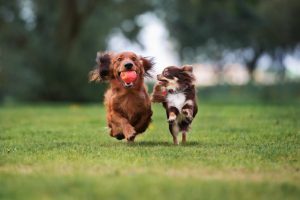First meeting with your dog and your new puppy
We used to be concerned if our pet dog was feeling lonely and needed a playmate besides us humans. Or sometimes you feel like having more love to share and it would be good if you adopted a new puppy to hug, play with, and sleep with. We are considering adopting a new puppy that could be a good companion to our old one. Having a lot of furry buddies in one home is a dream come true. However, for various reasons, introducing a new puppy to an older dog can be difficult. Dogs are very sensitive, especially if they are in a new environment and at the same time encounter a new member of the household. As a result, expect them to act in unusual ways. And we always need to watch for their first impressions, especially with our current dog that is used to being the only dog in the household. Prepare your home for the new dog. If your resident dog shows possessive behaviors in the past, you’d better prepare for it. The things your dog might guard, such as food bowls, beds, and toys, must be put in one place, separate from the things that belong to your new dog. That way, your resident dog won’t feel cranky as the new dog walks and sniffs around. And make sure to avoid cluttering things.

Congestion may trigger aggression in our pets if they are forced to have an interaction. Consider setting tangible boundaries like baby gates temporarily until they get used to interacting with each other as time goes by. Choosing an introduction spot It’s advisable to choose an introduction spot for dogs. It’s better to get help from a family member or friend to handle each dog. It is better to avoid using the house indoors as a meeting spot as resident dogs may become territorial and show signs of aggression. The yard, or a pet-friendly public park, or any open area could be a good option. During the new puppy’s introduction: This is the time you must elevate your escorting skills as your resident dog will be meeting a new furry member of the family. Putting them both on a leash is a must. And don’t forget to bring pet treats. And it’s recommended that you do this with another family member so that each dog has an escort for their first meeting

•. Go to the rendezvous location with the dogs separately. Bring the dogs together and let them greet each other. Humans must pay attention to the behavior of each dog. Keep the leashes slack to prevent dogs being tugged or held back.
•. Allow the dogs to sniff each other out. It’s their way of getting to know the newcomer. And besides sniffing, you might also expect them to pee, run in circles, play, or simply snub each other. They’re figuring out what kind of relationship they want to have
•. If the dogs try to fight, they will release their tension right away. But do not tug on the leash. Instead, distract them with treats and lure them away from each other. This is where you can observe if the dogs could be okay encountering each other, especially since you’re taking both of them into your home.

Keep the initial interaction brief, such as a short walk with them. If walking goes well with your new puppy and your resident dog, you may now try to take them home. You may let them play in your yard for a while before letting them into the house. It’s best to let the resident dog be the first one to go off leash, and then let the puppy sniff, run, and explore the house with the leash on. Always observe their behavior. If your resident dog is being friendly with the new puppy, you may take the puppy’s leash off and let them be together. But if they show signs of aggression and territoriality, it’s better if you separate them temporarily until they get used to each other’s interaction. The progress of the dogs getting used to each other in one home is gradual and might take a week or two. For your resident dog, just retain your normal routines like feeding, playing, walking, etc. As you also establish a routine for the new puppy, never leave them alone until you are certain that they are comfortable with each other. You may also hire a professional trainer if the relationship between the dogs and each other is not progressing. Adding a new furry member could be really exciting, but it requires a lot of work to be able to adjust for the sake of the welfare of our beloved pets.



